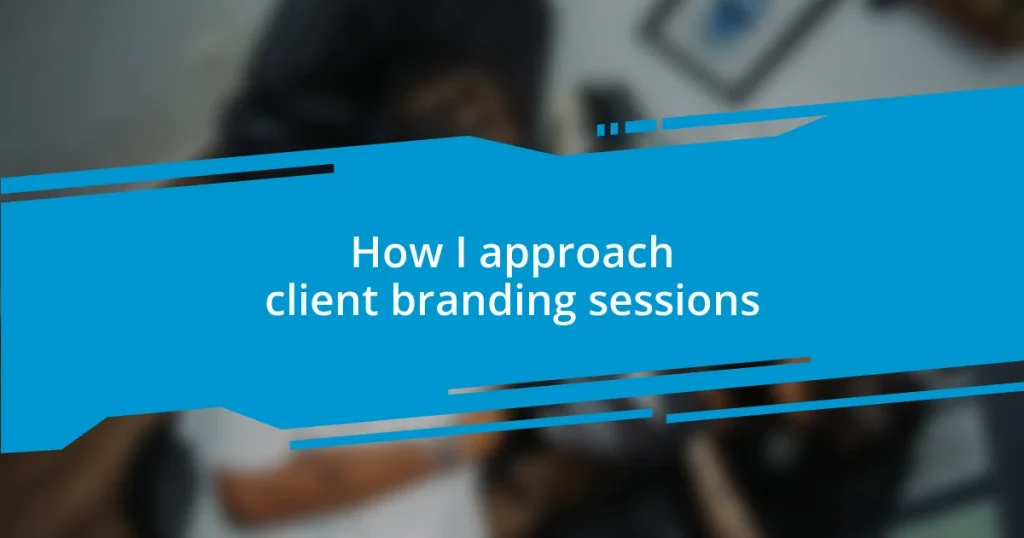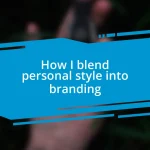Key takeaways:
- Understanding a client’s branding needs requires deep emotional connection and open-ended questions to reveal unique brand insights.
- Creating a supportive, collaborative environment fosters creativity, encourages client participation, and builds trust essential for a successful branding strategy.
- Implementing feedback and revisions is crucial for uncovering deeper emotional connections, leading to a brand identity that resonates with both the client and their audience.
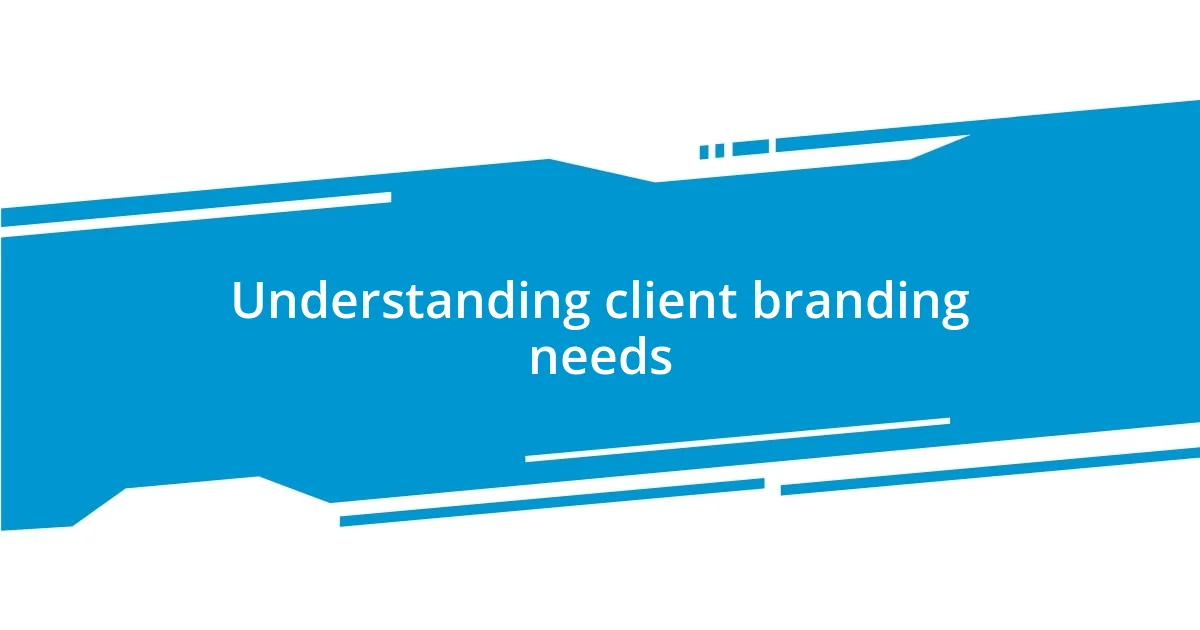
Understanding client branding needs
Understanding a client’s branding needs is like peeling back the layers of an onion. Each layer reveals deeper insights about their vision, values, and audience. I often ask myself, “What truly sets this brand apart?” It’s essential to identify what makes them unique in a crowded marketplace.
In one of my past sessions, a client described their business with such passion that it reminded me of my early entrepreneurial days. Their excitement was contagious, but I noticed they struggled to articulate their core message. This taught me that connecting emotionally with a brand is just as important as the strategic elements we often focus on.
I find that asking open-ended questions can unlock powerful insights. For instance, I might ask clients, “If your brand were a person, how would you describe its personality?” These conversations often lead to revelations about brand identity that clients hadn’t even considered. Recognizing these needs shapes a more authentic, compelling brand strategy.
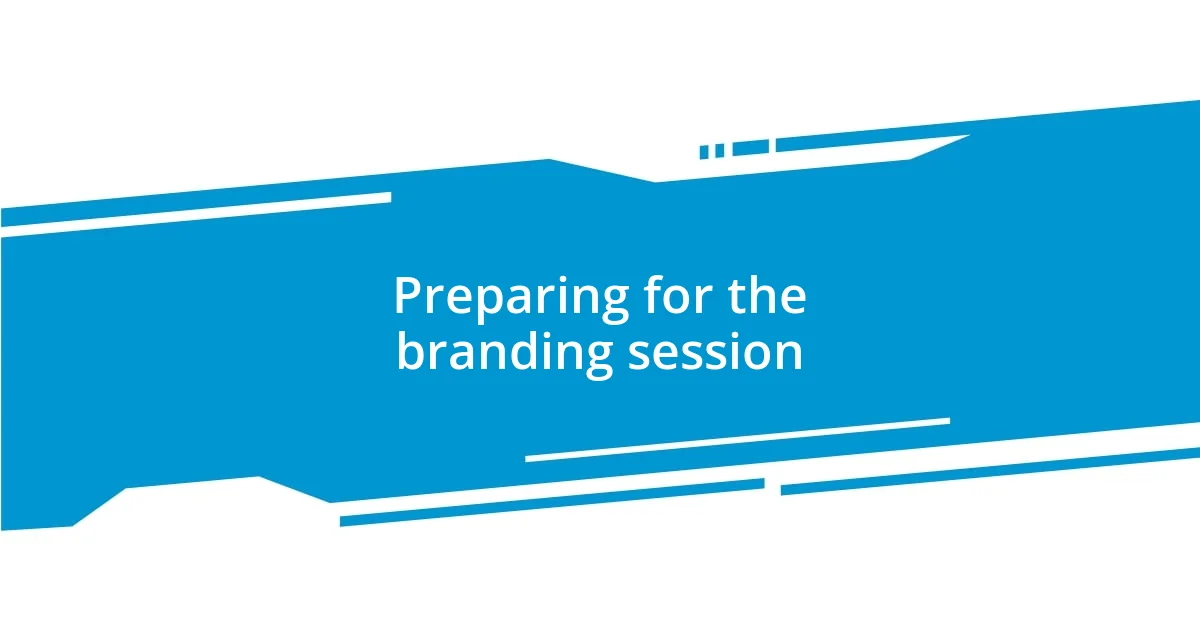
Preparing for the branding session
Preparing for a branding session is a critical step that involves more than just logistical arrangements. I often begin by gathering as much information as possible about the client’s industry, target audience, and competitors. This not only helps me to tailor the session but also allows me to approach it with an informed perspective. I recall a time when I immersed myself in a client’s niche market before a session, discovering trends and opportunities that sparked exciting discussions. This preparation paved the way for deeper conversations, and I felt more connected to their vision.
Here’s how I typically prepare:
- Review the client’s existing branding materials, like logos and taglines.
- Conduct research on industry trends and competitor brands.
- Develop a list of tailored questions based on my findings.
- Create a visually inviting space for the session to foster creativity and openness.
- Set clear goals for what we aim to achieve during our time together.
Each of these steps equips me with the tools to lead engaging discussions that delve into the heart of the brand, making the experience productive for both of us.
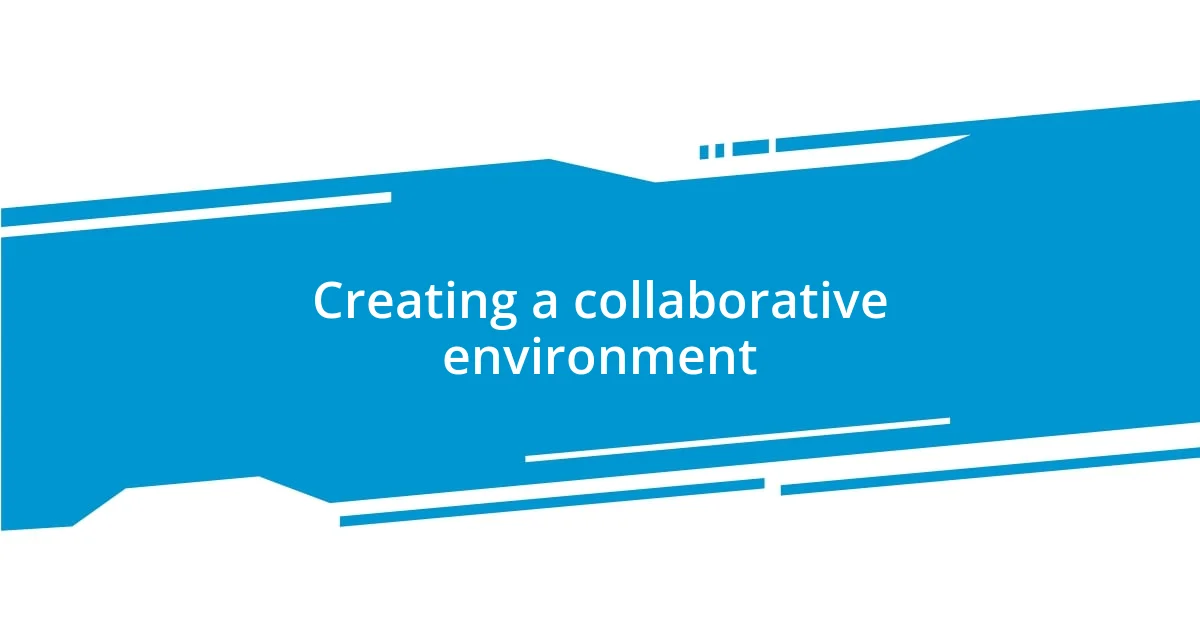
Creating a collaborative environment
Creating a collaborative environment is paramount in branding sessions. I remember one particular client who was anxious at first. To ease the tension, I encouraged them to share their thoughts freely, assuring them that their ideas mattered. The moment they opened up, the energy shifted, and we created an atmosphere of co-creation, which ultimately led to breakthroughs in their branding strategy. It’s amazing how a few supportive words can transform a session from a formal meeting into a creative workshop.
I often employ interactive activities to foster collaboration. For example, I use brainstorming techniques where we sketch ideas or map concepts together. I recall a session where we used sticky notes to jot down thoughts on brand values, and the walls soon filled up with vibrant ideas. It felt less like a traditional talk and more like a team effort. This physical engagement helps everyone feel more invested and sparks innovative thinking.
In my experience, showing vulnerability can also strengthen the collaborative environment. I once shared my own challenges in defining my brand clearly, which gave my client the encouragement to voice their hesitations too. This build-up of trust creates a space where both parties feel equal, paving the way for authentic communication. When clients feel this level of openness, the results are often transformative.
| Feature | Description |
|---|---|
| Open Communication | Encourages clients to freely express their thoughts and ideas. |
| Interactive Activities | Utilizes brainstorming techniques and visual aids to enhance engagement. |
| Trust Building | Involves sharing personal experiences to create a safe space. |
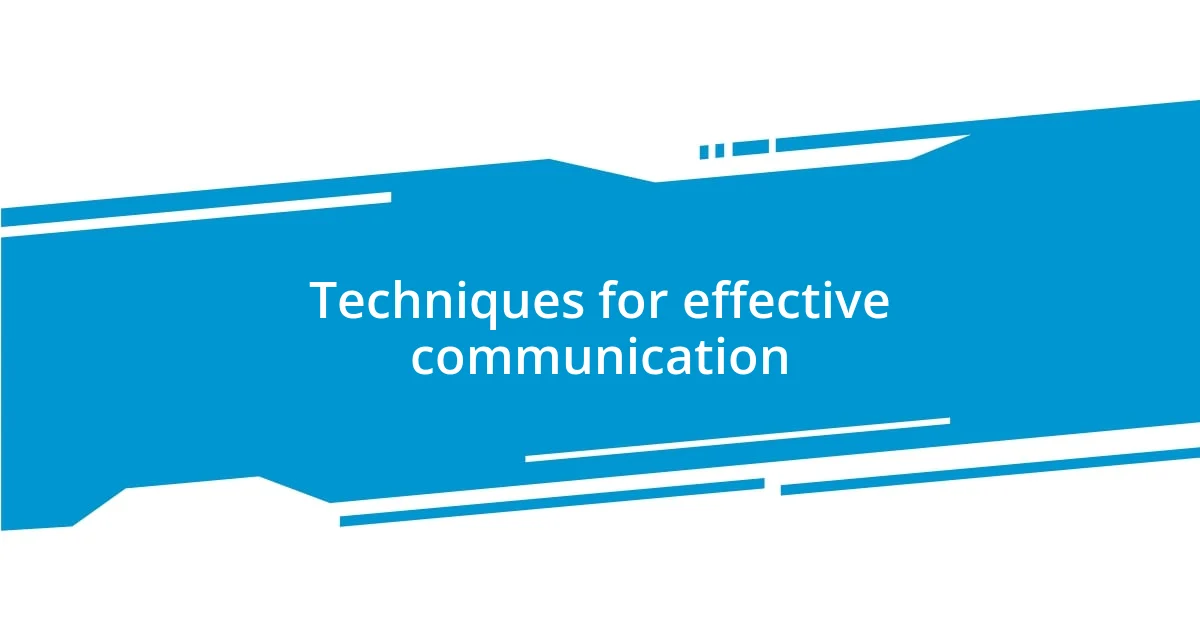
Techniques for effective communication
Effective communication in branding sessions hinges on my ability to listen actively. I find that when I genuinely listen and respond to my client’s concerns, it builds a level of trust that can’t be underestimated. For instance, there was a time when a client expressed doubts about their brand’s direction. By simply allowing them to articulate their feelings without interruption, I was able to clarify their vision and pivot our conversation toward solutions that resonated with them. Doesn’t it feel good to know someone truly hears you?
Another technique I often use is to rephrase my clients’ thoughts. This not only shows that I value their input but also helps to clarify any misconceptions. I remember a session where a client’s feedback was initially vague. By rephrasing their comments, I was able to pinpoint their concerns and mirror them back in a way that sparked further dialogue. It’s like a little dance, isn’t it? This back-and-forth creates a rhythm that enriches our discussions and reveals deeper insights.
I also embrace non-verbal cues, which play an incredibly significant role in communication. I always pay attention to facial expressions and body language; they often tell stories words cannot. I once noticed a client’s enthusiasm drop when discussing a particular idea. Recognizing this, I shifted our focus, which led us to explore an avenue that reignited their passion. Have you ever experienced that pivotal moment when you just knew a conversation was heading in the wrong direction? Trusting those instincts can illuminate the path forward.
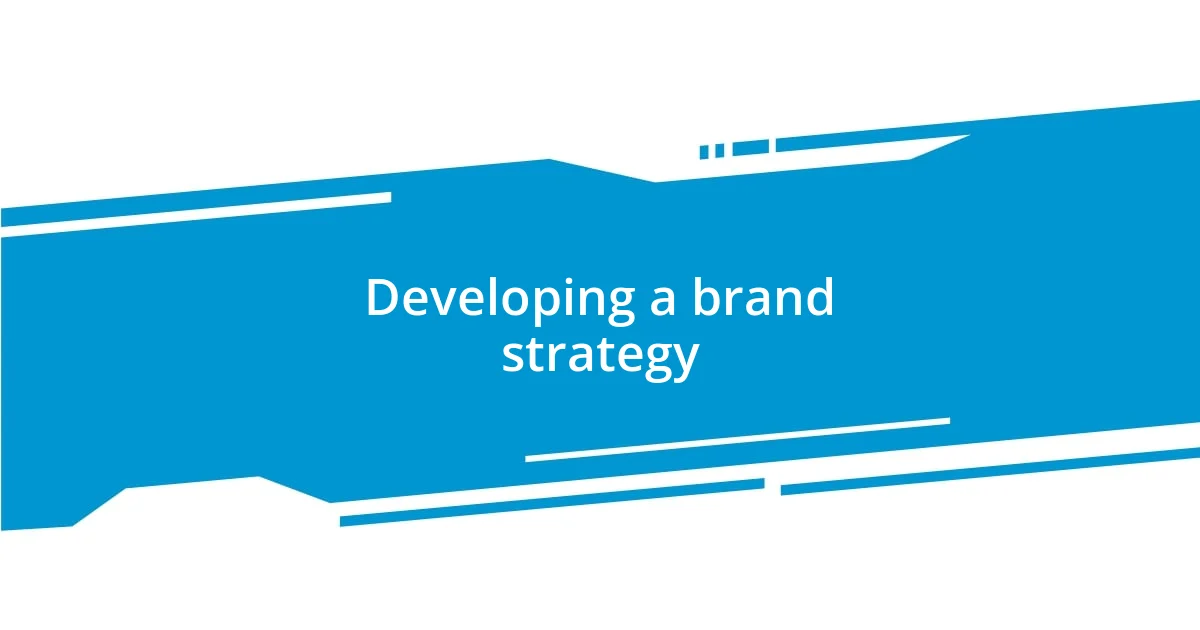
Developing a brand strategy
Developing a brand strategy is a nuanced process that requires deep introspection and thoughtful discussion. When I work with clients, I often encourage them to reflect on their core values and mission. I remember one session when a client struggled to articulate the essence of their brand. Through guided questions, we unearthed their passion for sustainability, which became the cornerstone of their strategy. Isn’t it fascinating how digging deeper can reveal the true heart of a brand?
Another vital aspect of shaping a brand strategy involves identifying the target audience. I find that clients sometimes overlook who they’re truly trying to reach. In one memorable session, we drew customer personas on large sheets of paper. This tangible exercise helped the client visualize their ideal customer and understand their needs better. Once they connected emotionally with their audience, the strategy began to evolve seamlessly. Have you ever experienced that moment when everything just clicks?
Additionally, I always emphasize the importance of a unique value proposition (UVP) in creating a brand strategy. This statement should encapsulate what sets the brand apart from competitors. I recall guiding a startup through this process; they initially focused on features rather than benefits. By shifting their perspective to what truly matters to their customers, we crafted a UVP that resonated deeply. It was a turning point, and watching their excitement as clarity emerged was incredibly rewarding.
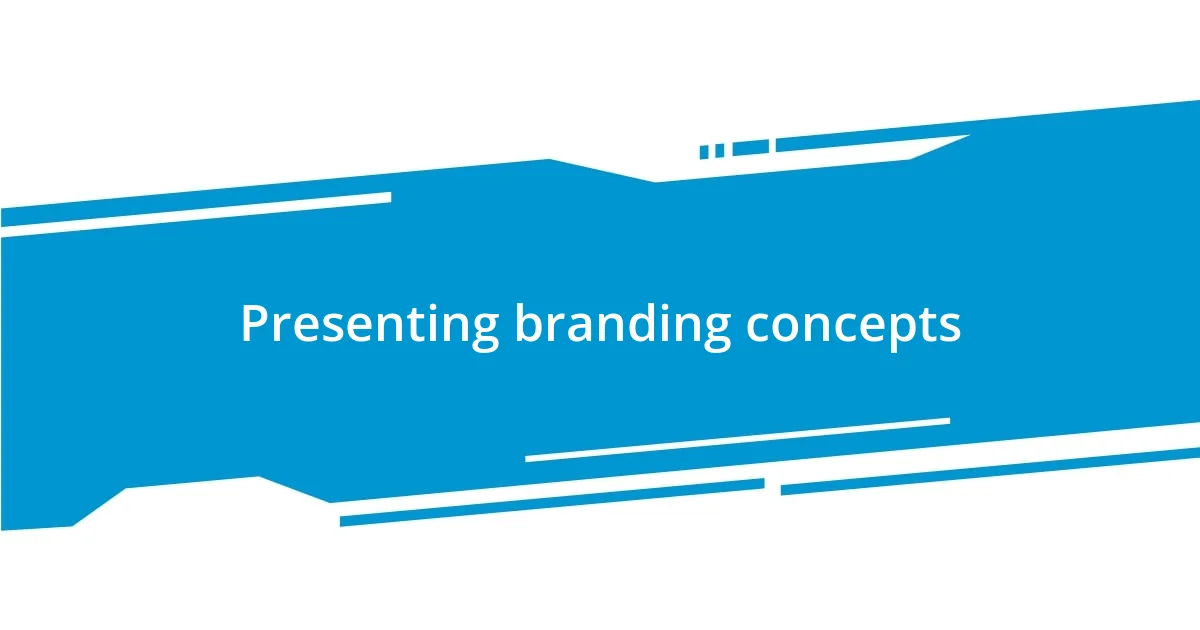
Presenting branding concepts
When presenting branding concepts, I believe it’s essential to create a narrative that resonates with the client. A few weeks ago, for instance, I shared a mood board filled with images and colors that reflected the essence of a brand we were developing. As I explained the rationale behind each choice, I could see my client’s eyes light up with recognition and excitement. It’s moments like these that deepen my conviction—do you ever find your ideas come to life when you share them visually?
I also find that involving clients in the process cultivates a sense of ownership over the concepts. During one session, I encouraged a client to brainstorm their own adjectives that describe their brand. The resulting list became a foundation for our brand messaging, and together we chose words that truly resonated with their vision. It was incredibly rewarding to witness their passion breathe life into the branding concepts. Don’t you think that collaboration transforms a mere idea into something much more powerful?
Moreover, I use storytelling techniques to provide context and purpose to each branding concept I present. I recall a time when I framed a brand’s journey as a relatable story, highlighting the challenges they aimed to solve and the impact they sought to create. This approach connected deeply with the client, allowing them to see their brand as part of a larger narrative. How powerful is it to imagine a brand that stands not just for a product, but for a meaningful story?
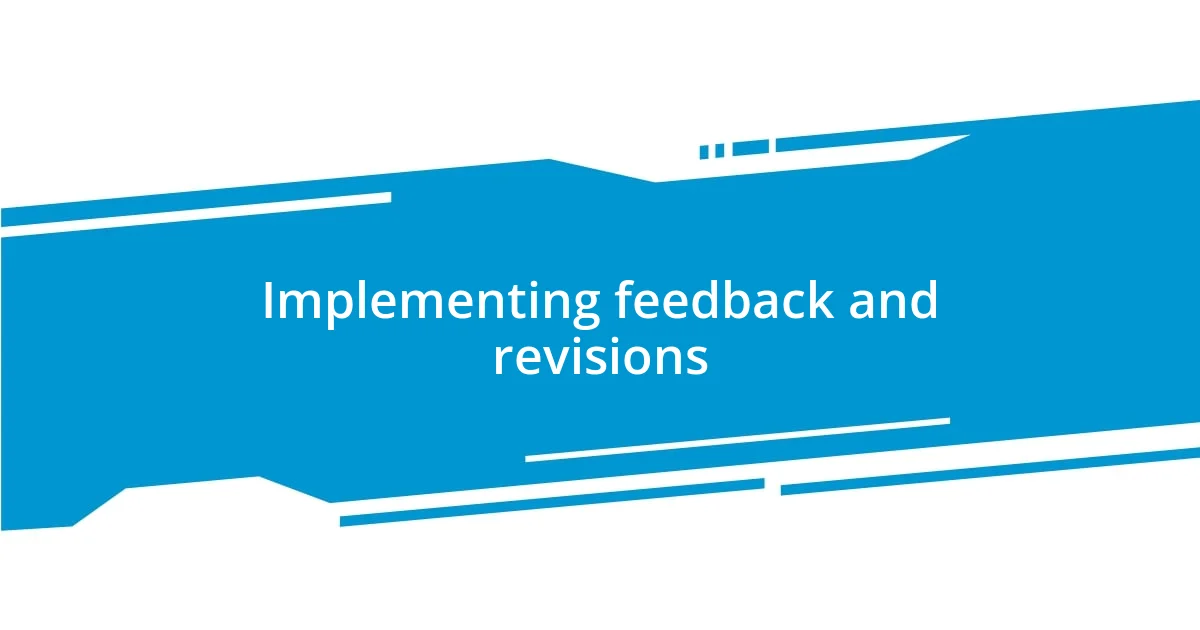
Implementing feedback and revisions
I’ve found that implementing feedback and revisions is where the real magic happens in branding sessions. I remember a project with a small coffee shop; after presenting initial concepts, the owner expressed doubt about the color scheme. I took their concerns to heart, and we initiated a collaborative revision session, diving into what each color represented for them. By tweaking elements together, they reconnected with their vision, and the outcome was a palette that perfectly reflected the warmth and vibrancy of their brand. Isn’t it fascinating how feedback can illuminate perspectives we might overlook?
Listening actively to client feedback can often reveal underlying emotions that drive their brand. I had a client who hesitated about the font choice; upon discussing it further, they shared a personal story about their grandmother’s love for calligraphy. This revelation guided us to select a typography that evoked nostalgia and warmth, resonating deeply with their target audience. It’s moments like these where I realize how crucial it is to view feedback as a gateway to deeper insights; it’s not just about revisions, but unlocking the soul of the brand.
Revisions can sometimes feel daunting, but I approach them as opportunities for growth. During a session with a tech startup, we had brainstormed an entire branding direction that was later met with mixed feelings. Embracing the challenge, I encouraged the team to point out what resonated and what didn’t, leading us to a robust discussion that revamped our approach entirely. This open dialogue transformed doubt into excitement, and in the end, we crafted a brand identity that truly represented their innovative spirit. Don’t you find it rewarding when a simple conversation leads to a breakthrough?










